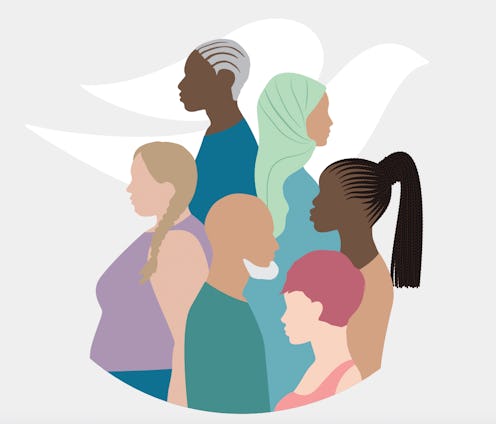(Mindfulness)
Impossible Beauty Standards Are Costing Us Billions, A New Report Finds
The emotional impact is even greater.

For as many strides as the beauty industry has made over the past decade, reminders of just how far it’s yet to go are everywhere. In a just-released report by the Dove Self-Esteem Project, the consequences of issues like workplace natural hair discrimination and sizeism can be measured both economically and emotionally — and both sets of facts and figures are equally sobering. Designed to get a firm, fiscally-focused grasp on the literal cost of measuring up to unrealistic beauty standards, the Dove Cost of Beauty Ideals report is a must-read.
Co-authored by S. Bryn Austin, ScD, professor of social and behavioral sciences at the Harvard T.H. Chan School of Public Health, and Jaime C. Slaughter-Acey, PhD, MPH assistant professor at University of Minnesota’s School of Public Health, the study focuses on several key, interconnected issues including colorism, body dissatisfaction, weight- and race-based hiring discrimination, and their financial toll on both individuals and society. “With this report, we take aim at racist and gendered societal appearance ideals, bringing much-needed scrutiny to a domain of inequity that for too long has been relegated to the periphery of economic and social inquiry,” the study begins, “no doubt both a consequence and a cause of the comparatively small research literature investigating this domain.”
The study’s findings, deduced with the help of Dove’s expert panel and Deloitte Access Economics, are extensive and extreme. Pointing out that girls as young as 10 are affected by pressure to adhere to strict, society-sanctioned standards, it’s girls and women from marginalized identity groups — including Black, indigenous, and other women of color — who are most heavily impacted economically. The study reports that appearance-based discrimination costs a whopping $501 billion annually, while body dissatisfaction totals more than $305 billion.
While that cost is spread between individuals, the U.S. government, and private employers, it’s no surprise that everyday citizens and their families shoulder the biggest portion of the financial burden — 32% of that total cost. Essentially, the U.S.’s already-pressurized economy is buckling under the weight of society’s self-imposed beauty ideals. Imagine how those resources, both personnel-wise and financial, could be spent were it not for discrimination and dissatisfaction.
As it happens, the emotional cost of being turned down for a job because of natural hair, disregarded by a medical professional over size, and the subsequent time, money, and effort poured in to altering one’s appearance to fit it is even greater — though harder to quantify with cold, hard numbers.
Dr. Nina Ellis-Hervey, licensed psychologist, professor, life coach and DevaCurl Expert Curl Council member, says the emotional impact of discrimination and dissatisfaction can even manifest itself physically. Along with anxiety, depression, and body dysmorphic disorder, “studies have shown that people who experience looks-based discrimination are more likely to suffer from high blood pressure, heart disease, and obesity,” Dr. Ellis-Hervey explains. “So, not only is this type of discrimination harmful to our mental health, but it could also pose serious threats to our physical health.”
Just as with fiscal ramifications, the brunt of the emotional burden is shouldered by Black women and other women of color. “The emotional toll of not being able to show up as your authentic self is exhausting to say the least,” says Alicia Williams, Senior Director of Anti-Racism and Racial Equity at DevaCurl. “It is having to constantly plan ahead to minimize potential comments from coworkers, family, and friends.”
In Dove’s study, a staggering 27 million people in Black communities face skin shade discrimination, while another 5 million are forced to deal with natural hair discrimination — and that’s while simultaneously navigating the intersectional issue of weight-based cruelty, too. “While we see a renaissance of embracing natural hair, there are still many Black and Brown people who work in industries that do not support natural hairstyles, whether it be explicitly in an employee handbook, or unspoken through lack of representation in leadership,” Williams says.
There’s no denying the heavy, heavy cost — both economic and emotional — of our impossibly rigid beauty standards. But while the situation is dire, it’s not a hopeless one. Williams is confident there is a future in which natural hair discrimination is gone for good, and points to elements like media representation, thoughtful leadership, and a beauty industry that celebrates and caters to natural hair as tools to help get there. “People want to see themselves! When you see yourself and not just very narrow views of beauty represented, it is empowering.”
On an individual level, digging yourself out of a self-esteem spiral can be tough. Dr. Ellis-Hervey says developing genuine body positivity takes time, but is indeed possible to achieve. She suggests adjusting your social media feeds to show body-positive creators, messages, and media, engaging in feel-good activities like endorphin-boosting walks, and consuming professional media with a critical eye. Importantly, though, she underscores that professional help can get to the root of individual issues. “Remember that you are worthy and deserving of love and respect — regardless of your body size or shape.”